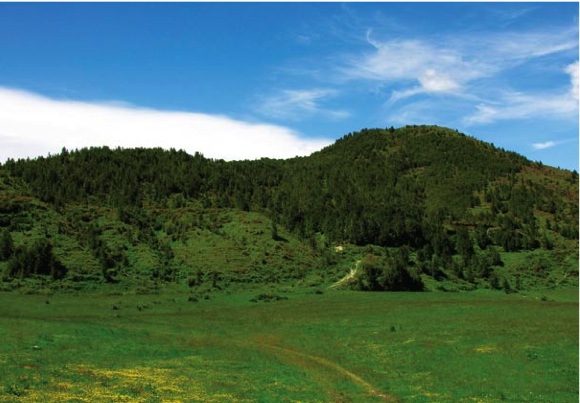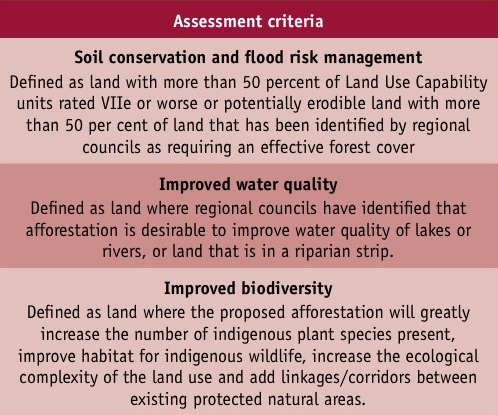Afforestation Grant Scheme now open for business
Peter Gorman, New Zealand Tree Grower August 2008.
The government’s new Afforestation Grant Scheme (AGS) was launched by the Minister of Forestry Jim Anderton last month and is now open for business.
The AGS is one of a range of new initiatives announced by the government to address the effects of climate change.
Contestable fund
The scheme, which is administered by MAF, is a contestable fund aimed at encouraging more forestry planting. It offers an alternative for landowners to the Permanent Forest Sink Initiative, or the proposed New Zealand Emissions Trading Scheme (ETS) to encourage greater levels of greenhouse gas absorption by increasing the area of Kyoto- compliant forest in New Zealand. The main purpose of the ETS is to enable New Zealand to meet its Kyoto obligations in the long term at the lowest cost. However it is also expected to boost afforestation. Kyoto-compliant forest is forest planted on land that did not have a forest cover at 31 December 1989.
The aim is to keep the scheme as simple as possible with minimum administrative costs.
Accounting for carbon
Forests contribute to the mitigation of climate change by converting carbon dioxide from the atmosphere into carbon stored in wood. Forests also help reduce the likely effects of climate change, for example, by reducing erosion, nutrient leaching and flood peaks.
The Kyoto Protocol means that New Zealand has to account for carbon stock changes in forests planted after 1989. Net increases in forest carbon stocks can be used to offset greenhouse gas emissions from other sectors in the economy. The rate of new afforestation in New Zealand since 1990 has been irregular, with a large bulge in the mid-1990s. Therefore future carbon stocks will follow the same irregular pattern, with cyclical net increases and decreases in carbon stocks.
New afforestation, encouraged by either the AGS or the ETS, will even out the age class distribution of the Kyoto forests and reduce the risk of net carbon stock decreases in the future. Under the AGS, foresters can receive a government grant for planting new forests on Kyoto-compliant land. Those who receive grants under the scheme will own the new forests and earn income from the timber when harvested. The Crown will retain the carbon sink credits and take responsibility for meeting all harvesting and deforestation liabilities.
Priority will be given to afforestation proposals that will also reduce the risk of soil erosion, improve water quality and biodiversity. Each tender will be scored in relation to these three environmental co-benefits. Tenders will be allocated according to their tender price and their environmental score.
Two ways of funding
There are two funding components to the AGS. Half of the funding will be available to regional councils to help them meet their sustainable land management objectives through afforestation. Some councils have already identified land where afforestation is desirable for environmental reasons. They will be able to implement programmes using AGS funding under conditions specified by MAF. The councils will provide information on their achievements, and make claims for payment. MAF will audit a sample of sites for compliance.
 The other half of the funds will be available directly to the general public via a public tender pool. The majority of this public funding pool, 70 per cent, will be allocated to species that have high sequestration rates. These will be the usual exotic plantation species such as radiata pine and Douglas fir. The remaining 30 per cent of these public funds will be reserved for species with low carbon sequestration rates. This is as a result of public interest in planting indigenous species, which have low carbon sequestration rates, but may have high costs. Maximum grant rates will be set for each sequestration category and they will not be disclosed publicly.
The other half of the funds will be available directly to the general public via a public tender pool. The majority of this public funding pool, 70 per cent, will be allocated to species that have high sequestration rates. These will be the usual exotic plantation species such as radiata pine and Douglas fir. The remaining 30 per cent of these public funds will be reserved for species with low carbon sequestration rates. This is as a result of public interest in planting indigenous species, which have low carbon sequestration rates, but may have high costs. Maximum grant rates will be set for each sequestration category and they will not be disclosed publicly.
Securing biodiversity
The tree species in an application must have the potential to meet the definition of forest land as shown in the accompanying box. The trees must be compatible with the site where they will be planted. Indigenous species should be eco-sourced ? endemic to the locality. Forest species that have been identified in regional council pest management strategies as having weed potential will be ineligible.
This mix of high and low sequestration rates helps to secure biodiversity as well as spreading risk and potential harvest liabilities for the government. Low sequestration rate species will not be harvested at the same rate as high rate species.
In the public tender pool, if the low sequestration rate category is under-subscribed in any particular year, then the surplus may be transferred to the high sequestration category. Similarly, if the total public pool is under-subscribed, then the surplus may be transferred to the regional council pool.
Eligibility
What land is eligible for a grant?
Land eligible for a grant must be land that
- Was not forest land on 31 December 1989 or
- was forest land on 31 December 1989 but was deforested between 1 January 1990 and 31 December 2007 or was deforested on or after 1 January 2008 and in respect of which any liability to surrender units arising to the Crown under the Kyoto Protocol have been satisfied.
Forest land is defined as –
A minimum area of land of one hectare with tree crown cover or equivalent stocking level of more than 30 per cent in each hectare, with the potential to reach a minimum height of five metres at maturity in situ.
A guide for determining whether a forest meets this definition is available and applies to afforestation under the AGS, the ETS and the PFSI.
Provided their land meets certain eligibility criteria, land owners can either tender directly for an AGS grant from the public pool, or obtain a grant through their Regional Council.
To be eligible for carbon sink credits under the Kyoto Protocol, a grant forest must be ‘direct human induced...through planting, seeding and/or the human-induced promotion of natural seed sources.’ This means some form of active management will be required in establishing the forest. Forests may be planted or developed by assisted natural reversion. The AGS minimum standard for planted forest establishment is ‘seedlings, cuttings or other plant material achieving a minimum stocking of 750 stems per hectare and free of significant weed competition.’
For planted indigenous forest, the minimum stocking may consist of other species, such as manuka planted with a dominant species like kahikatea or kauri.
With indigenous reversion blocks, an applicant must provide a brief management plan. This should detail the measures that will be taken to ensure that succession to indigenous forest will occur with reasonable certainty – for example, fencing, exclusion of livestock, control of wild animal herbivores or supplementary planting.
A forest may be established for wood production purposes, other environmental purposes or a combination of both.
Size and timing
Ranking of tenders
Each tender will be scored according to the three following co-benefit criteria.

The minimum application size is five hectares, which may consist of multiple areas of at least one hectare. Shelterbelts or riparian strips less than 30 metres wide from canopy edge to canopy edge are not eligible. However afforestation on both sides of a waterway can be assessed as one riparian strip with the width of the waterway excluded from the measurement.
The normal timing of the annual tender programme is for tenders to close on 30 April, with provisional approval given by 30 June. Tenders can be submitted for planting in the current or following calendar year. Due to the timing of the scheme start-up, the closing date for 2008 tenders was 30 June. A tender may be approved conditionally if the applicant has to acquire a land title, forestry right or resource consent. These applicants will have 12 months to obtain the necessary consents.
A successful tender will be offered a grant agreement that will include the following terms –
- The term of the agreement will be 10 years
- The grantee can make a claim for payment when the grant forest is successfully established
- If the grant forest is deforested within the term of the agreement, the grant plus interest is repayable
- If the grantee transfers the grant-aided forest, the grantee is obliged to transfer the contract to the transferee
- The scheme administrator has the right to access the land for carbon measurement purposes.
Claims for payment
A grantee may lodge a claim for payment when the forest is successfully established including a statutory declaration to that effect, and when a map of the planted area is supplied. Normally, this will be at least six weeks after the tree releasing operation in the spring following planting. With assisted indigenous reversion, a claim may be lodged when the operations specified in the application such as fencing or animal control have been completed.
The administrator will audit a proportion of claims to confirm compliance with the establishment standard, and will generally make payments within 30 working days of receiving claims. Adjustments may be made to claims if part of the application area is deemed to have not met the standard.The Crown will accept the risk of carbon loss in a grant-aided forest from fire, wind, other natural disasters.
The Afforestation Grant Scheme Guidelines which contain full details of the scheme, the tender application forms and the grant contract documents are now available from the MAF website www.maf.govt.nz or from MAF regional offices. Interested parties can also contact 0800 CLIMATE or email climatechange@maf.govt.nz

 Farm Forestry New Zealand
Farm Forestry New Zealand